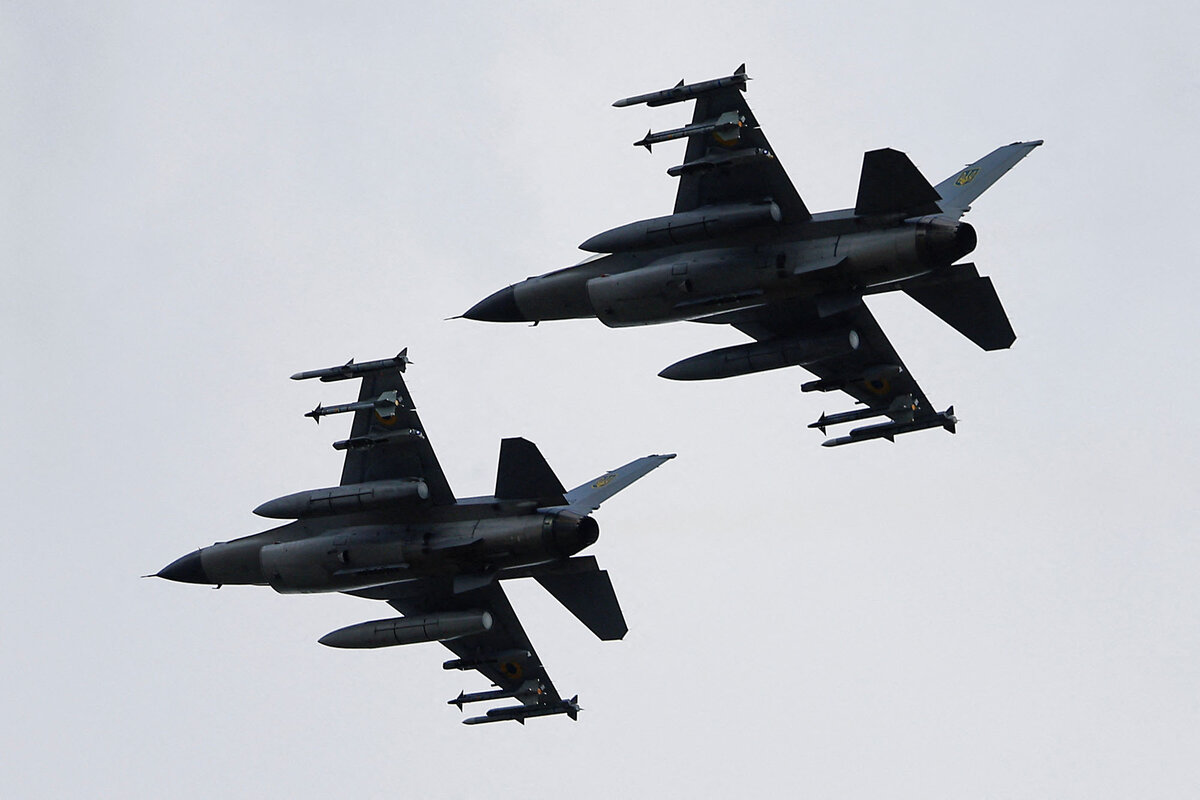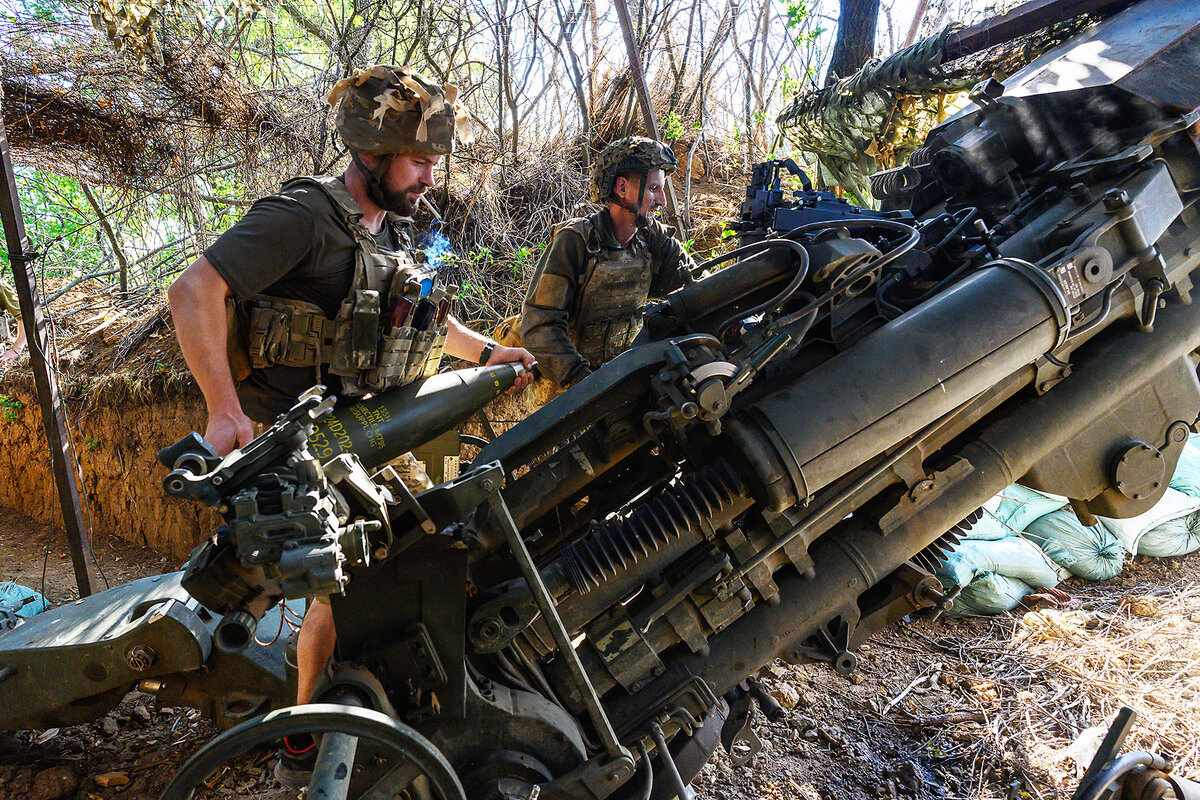US weapons help Ukraine advance. Will concerns about corruption put that at risk?
Loading...
New weapons and big-ticket items, including American-made F-16 fighter jets, have been surging into Ukraine this month, giving striking steam to the latest efforts to beat back the Russians, including a recent cross-border foray into Kursk.
Fueling such efforts is a major package of defense aid – $58 billion committed in security assistance – that Congress released earlier this year. How to track all that money has increasingly been on the minds of American military experts.
Why We Wrote This
A story focused onSpending taxpayer dollars on foreign wars is a tough sell for most Americans, so ensuring accountability in Ukraine aid matters. Some experts call for more safeguards against corruption.
That’s because corruption can threaten Ukrainian morale and success – and make U.S. lawmakers skeptical of providing more aid in the future.
While the Ukrainian government is trying to fight graft, the United States must still do its part, analysts say. It has yet to hire an independent special inspector general to track U.S. security assistance, for example, despite calls to do just that.
A righteous cause and corruption can coexist, says Col. Patrick Sullivan, director of the Modern War Institute at West Point.
Without accurate monitoring of equipment, U.S. strategic planners could be stuck with flawed insights for both Ukraine’s war-fighting effectiveness and America’s own use in potential future conflicts.
New weapons and big-ticket items, including American-made F-16 fighter jets, have been surging into Ukraine this month, giving striking steam to the nation’s latest efforts to beat back the Russians, including a cross-border foray into Kursk.
The region’s governor reported to Moscow this week that Ukrainian forces have made it more than 7 miles, across a 25-mile front, into Russian territory.
Fueling such efforts is the major defense aid package that Congress released for Ukraine earlier this year. Indeed, the question of how to keep track of all that money – $58 billion committed in security assistance – has increasingly been on the minds of American military officials and experts.
Why We Wrote This
A story focused onSpending taxpayer dollars on foreign wars is a tough sell for most Americans, so ensuring accountability in Ukraine aid matters. Some experts call for more safeguards against corruption.
That’s because corruption can threaten Ukrainian morale and success – and make U.S. lawmakers skeptical of providing more aid in the future.
U.S. officials are keenly aware, however, that it’s a tricky topic to raise. Graft seems a bit pedestrian compared with, say, Ukraine’s battle against Russia.
Ukrainians deserve their “well-earned status as noble warriors for a righteous cause,” notes Col. Patrick Sullivan, director of the Modern War Institute at West Point. Still, he adds, “Righteousness and corruption can coexist.”
Corruption has long been a large problem in Ukraine – President Volodymyr Zelenskyy’s election campaign railed against it – and it would be unwise to ignore its pervasiveness and insidious effects, analysts say.
For starters, back-burnering malfeasance, usually in the form of graft, risks repeating the kind of disastrous mistakes that the United States made in Afghanistan. The government in Kabul never gained full legitimacy among the people, due in no small part to corruption, and ultimately failed to win its war against the Taliban. This despite the two decades that U.S. troops spent training local forces as well as several hundred billion dollars’ worth of U.S. military aid.
Mr. Zelenskyy seemed to reinforce ongoing corruption concerns when he last year fired his defense minister – widely liked in the West and key to putting together an arms coalition – for failing to root it out. Earlier this year, Kyiv’s new defense minister suspended a senior official being investigated for graft while buying weapons.
Still, the U.S. must do its part, too, analysts say. It has yet to hire an independent special inspector general to track U.S. security assistance to the country, for example, despite calls to do just that. A U.S. government watchdog earlier this year found that after providing more than $42 billion in security assistance since February 2022, the Pentagon “does not have quality data to track delivery of defense articles to Ukraine.”
Such data is essential not just to avoid wasting vast sums of money or putting it in the pockets of criminals, but also for the U.S. to have clarity on what makes for effective fighting.
“It’s not entirely altruistic when we support other nations with our arms,” says Colonel Sullivan. It allows the U.S. military to test weapons and teaches Pentagon planners tactical and strategic lessons. Only if the equipment is properly tracked, however, can America best assess its efficacy in future wars, he adds.
Calling on the “presidential drawdown authority”
Today, the sheer “value of the defense articles provided [to Ukraine] and the speed with which it has been delivered has raised concerns from congressional stakeholders about efforts to monitor” it, the U.S. Government Accountability Office (GAO) warned in a report released earlier this year.
Since 2021, the U.S. has used what’s known as the presidential drawdown authority to send weapons to Ukraine. In this case, the president can authorize the immediate transfer of arms and services from U.S. stocks, up to a funding ceiling, in response to an “unforeseen emergency.”
Historically, U.S. law has capped the maximum value of defense goods provided under the presidential drawdown authority at $100 million per year. For Ukraine, however, Congress increased this cap from $11 billion in 2022 to $14.5 billion in 2023. As of last September, the president had approved 47 separate drawdowns, which amount to some $24 billion, according to the GAO.
Under the separate Ukraine Security Assistance Initiative – created in 2015 after Russia’s 2014 invasion of Crimea – Congress has spent some $19 billion to buy artillery, ammunition, tanks, and medical supplies, along with services like vehicle maintenance, directly from the private sector or foreign partners on behalf of Kyiv.
Pentagon lacks a single standard for tracking weapons shipments
Amid all this, the Pentagon must determine to what extent providing ammunition and weapons from its own stocks reduces the arms available for training U.S. troops and responding to America’s own emergencies.
To this end, it helps to know where all of these arms are at any given time. As they make their way to Ukraine, however, the separate U.S. military services use vastly different methods of determining when weapons and supplies arrive at their destination.
The Army, for example, considers weapons and supplies delivered “as soon as they begin movement from Army points of origin, which are generally storage facilities in the U.S.,” the GAO notes. The Navy, by contrast, checks this box “once they arrived at their designated overseas delivery location,” rather than when delivered to Ukrainian officials. For the Marines, it’s “when they receive email confirmation.” The Air Force “had not determined a standardized delivery confirmation process,” the GAO report notes.
“Without clarifying the guidance for data entry or taking steps to address potentially inaccurate data,” the report says, “DOD will be unable to assess the extent to which the defense articles are meeting recipients’ needs or U.S. objectives in Ukraine.”
It concluded, “For the purposes of advising their Ukrainian counterparts, [defense officials] were confident they had reliable information,” though “they acknowledged there continued to be weaknesses that warranted attention.”
Does U.S. need an independent inspector general for Ukraine?
Such attention should include establishing an independent inspector general for Ukraine, says retired Col. Mark Cancian, who worked for years on Pentagon budget strategy and war funding issues.
Though he sees no current evidence of widespread corruption connected to U.S. weapons flowing into Ukraine – and though there are inspectors general at the Pentagon and other U.S. agencies who already monitor aid – critics in Congress “are ready to pounce” on any cases of graft that might come to light, says Mr. Cancian, now a senior adviser at the Center for Strategic and International Studies.
Colonel Sullivan agrees, citing benefits that an independent inspector general would bring to U.S. national security as well.
U.S. strategic planners are carefully tracking how Russia wages war, mostly to learn how to best respond should the need arise.
Without accurate monitoring of equipment, those insights could be flawed, limiting not only U.S. strategic gains but also Ukraine’s war-fighting effectiveness.
“If you’re losing a lot of tanks or losing a lot of personnel because of bad tactics or bad operational decisions – or if there’s something about the technology that’s ill-suited for the battlefield – then you’ll adjust your tactics,” says Colonel Sullivan.
But first, the U.S. must be very clear on “how this stuff is being employed,” he adds, “and to what effect.”










